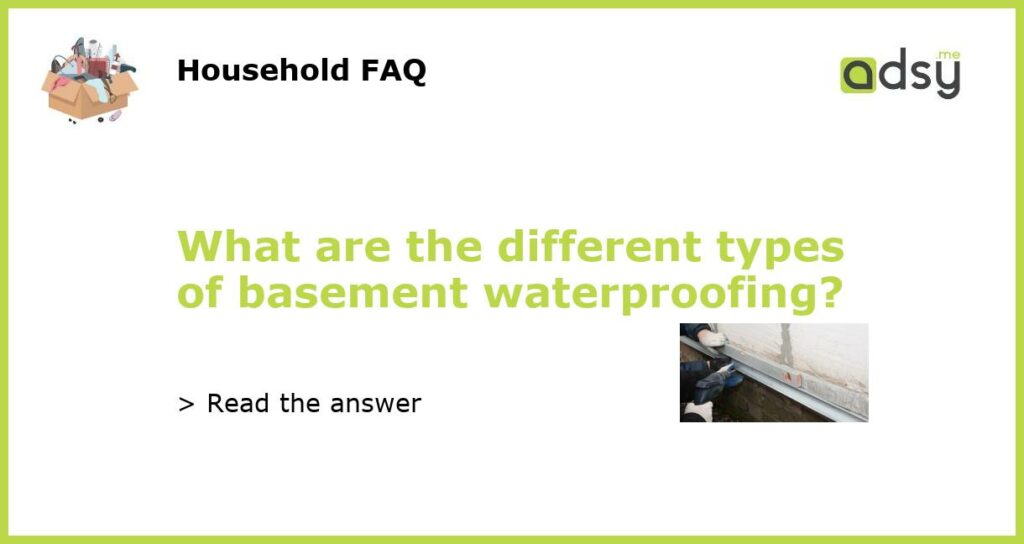The Different Types of Basement Waterproofing
Basement waterproofing is a crucial step in protecting your home from water damage. Whether you have a finished basement or just use it for storage, it’s important to keep it dry and free from moisture. There are several different types of basement waterproofing methods that can be used to achieve this goal. In this article, we will discuss five of the most common types of basement waterproofing.
Exterior Waterproofing
Exterior waterproofing is a method that focuses on preventing water from entering the basement in the first place. This method involves excavating the exterior of your home and applying a waterproof barrier to the foundation walls. This barrier is typically made of a rubberized or liquid waterproofing membrane that is applied to the walls and then covered with a protective layer of gravel or soil. By preventing water from reaching the foundation, exterior waterproofing helps to keep the basement dry and free from moisture.
One of the main benefits of exterior waterproofing is that it provides a long-lasting solution for basement waterproofing. The waterproof barrier is designed to withstand the elements and can provide protection for many years. However, this method can be costly and disruptive, as it requires excavation and potentially removing landscaping or other structures that are located near the foundation.
Interior Waterproofing
If exterior waterproofing is not feasible or cost-effective, interior waterproofing is another option to consider. This method involves installing a waterproofing system on the inside of the basement to redirect water away from the foundation. Interior waterproofing systems typically include a drainage system, such as a sump pump, that collects water and safely removes it from the basement.
The installation process for interior waterproofing is less invasive and disruptive compared to exterior waterproofing. It can be done without excavating the exterior of the home, making it a more cost-effective solution in certain situations. However, interior waterproofing is not as effective as exterior waterproofing in preventing water from reaching the foundation walls. It focuses on managing water that has already entered the basement, rather than preventing it from entering in the first place.
Concrete Waterproofing
Concrete waterproofing is a method that involves treating the concrete walls and floors of the basement to make them more resistant to water penetration. This is typically done by applying a waterproofing coating or sealant to the concrete surface. The coating forms a protective barrier that helps to prevent water from seeping through the concrete and into the basement.
Concrete waterproofing can be an effective solution for preventing water damage in basements, especially if there are small cracks or gaps in the concrete. The coating or sealant fills these gaps, making the concrete more water-resistant. However, it is important to note that concrete waterproofing is not a standalone solution and should be used in conjunction with other basement waterproofing methods for optimal results.
Basement Drainage Systems
Basement drainage systems are designed to collect and remove water that enters the basement. These systems typically consist of a network of pipes and drains that direct water away from the foundation and into a sump pump or other drainage outlet. By removing water from the basement, drainage systems help to keep the space dry and free from moisture.
There are different types of basement drainage systems available, including French drains, channel drains, and surface drains. The type of drainage system that is best suited for your basement will depend on factors such as the severity of the water problem and the layout of your basement. Consulting with a professional waterproofing contractor can help determine the most appropriate drainage system for your specific needs.
Crack Injection
If you have cracks in your basement walls or floors, crack injection can be an effective method to waterproof them. This method involves injecting a specialized waterproofing material, such as epoxy or polyurethane, into the cracks to seal them and prevent water from entering through them.
Crack injection is a relatively quick and cost-effective solution for addressing small to moderate cracks in basement walls and floors. However, it is important to note that this method is not suitable for large structural cracks or foundation issues. In such cases, it is recommended to consult with a professional to assess the extent of the damage and determine the appropriate waterproofing solution.

